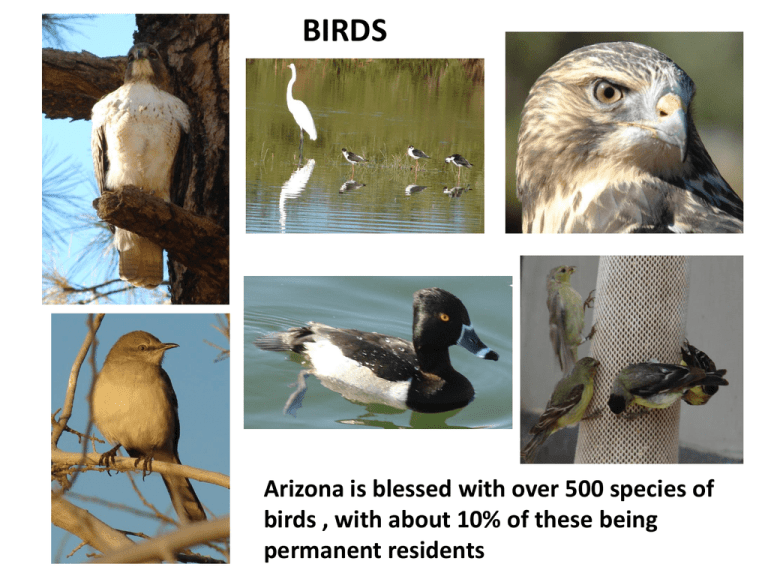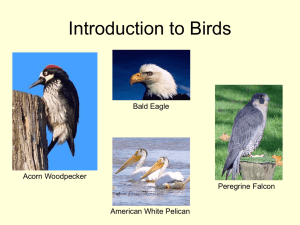Birds - Dinchak
advertisement

BIRDS Arizona is blessed with over 500 species of birds , with about 10% of these being permanent residents A BIRDS SKELETON A. Bones are hollow with air sacs B. Thin walled bones are strengthened by struts C. Forelimbs are modified into wings A BIRDS SKELETON D. Typically, the Achilles tendon continues past the heel to the 4 toes providing a perching mechanism E. Breast flight muscles attach to a prominent keel on the sternum A BIRDS SKELETON F. Horny beak adapted to diet, no teeth G. 8-24 neck vertebrae in an extremely flexible neck, may rotate through 280o A BIRDS SKIN A.Scales present on legs and feet o B.Body covered with feathers Vane 1. Contour feathers streamline + protect body, + form flight surface of wing Shaft 2. Down insulates the body Quill Vane composed of barbs A BIRDS SKIN C. No skin glands. Preen gland located at base of tail produces oil to lubricate feathers and skin D. Feathers are periodically shed or molted A BIRDS CIRCULATORY SYSTEM A. Four chambered heart, with two atrium (receiving) + two ventricles (pumping) C. Nucleated red blood cells contain hemoglobin for oxygen transport D. High heart rate i.e. Hummingbirds= 1260/ minute + sparrows = 500/minute A BIRDS DIGESTIVE SYSTEM A.Food stored in crop before being ground up by gizzard. Intestine absorbs nutrients. Feces exit via cloaca. A.Food passes through system quickly, 30 minutes in some species. Yet high proportion of nutrients are extracted A BIRDS EXCRETORY SYSTEM A.Kidneys excrete uric acid in a paste form to be mixed with feces in cloaca. B. No urinary bladder- this lightens the load. C. C. Nasal salt gland ( in roadrunner & marine birds) excretes excess salts from blood THERMOREGULATION A. Endothermic, heat source within cells, not dependent on solar radiation for heat source B. Homeothermic, body temperature rather constant: can be maintained independent of ambient temperature C. Active temperature commonly 100-102 degrees F REPRODUCTION A. Establishment of territory and complex mating rituals utilize vocalizations and displays. Copulation is by opposition of cloacal apertures. B. Incubation of eggs is followed by extended period of parental feeding + care. C. Egg shells harden by calcium salts. NERVOUS SYSTEM A. Large part of the brain devoted to vision + coordination of muscles B. Keen eyesight: can see color: can change focus from near to distant objects very quickly. Predatory birds typically have binocular vision C. Nocturnal birds with extremely acute hearing, usually cannot see colors. D. Except for vultures, most birds are not known to have a keen sense of smell











